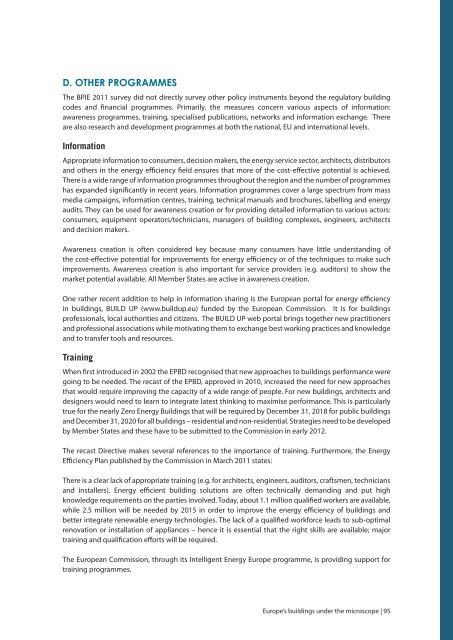BPIE: Europe's buildings under the microscope - PU Europe
BPIE: Europe's buildings under the microscope - PU Europe
BPIE: Europe's buildings under the microscope - PU Europe
Create successful ePaper yourself
Turn your PDF publications into a flip-book with our unique Google optimized e-Paper software.
D. O<strong>the</strong>r Programmes<br />
The <strong>BPIE</strong> 2011 survey did not directly survey o<strong>the</strong>r policy instruments beyond <strong>the</strong> regulatory building<br />
codes and financial programmes. Primarily, <strong>the</strong> measures concern various aspects of information:<br />
awareness programmes, training, specialised publications, networks and information exchange. There<br />
are also research and development programmes at both <strong>the</strong> national, EU and international levels.<br />
Information<br />
Appropriate information to consumers, decision makers, <strong>the</strong> energy service sector, architects, distributors<br />
and o<strong>the</strong>rs in <strong>the</strong> energy efficiency field ensures that more of <strong>the</strong> cost-effective potential is achieved.<br />
There is a wide range of information programmes throughout <strong>the</strong> region and <strong>the</strong> number of programmes<br />
has expanded significantly in recent years. Information programmes cover a large spectrum from mass<br />
media campaigns, information centres, training, technical manuals and brochures, labelling and energy<br />
audits. They can be used for awareness creation or for providing detailed information to various actors:<br />
consumers, equipment operators/technicians, managers of building complexes, engineers, architects<br />
and decision makers.<br />
Awareness creation is often considered key because many consumers have little <strong>under</strong>standing of<br />
<strong>the</strong> cost-effective potential for improvements for energy efficiency or of <strong>the</strong> techniques to make such<br />
improvements. Awareness creation is also important for service providers (e.g. auditors) to show <strong>the</strong><br />
market potential available. All Member States are active in awareness creation.<br />
One ra<strong>the</strong>r recent addition to help in information sharing is <strong>the</strong> <strong>Europe</strong>an portal for energy efficiency<br />
in <strong>buildings</strong>, BUILD UP (www.buildup.eu) funded by <strong>the</strong> <strong>Europe</strong>an Commission. It is for <strong>buildings</strong><br />
professionals, local authorities and citizens. The BUILD UP web portal brings toge<strong>the</strong>r new practitioners<br />
and professional associations while motivating <strong>the</strong>m to exchange best working practices and knowledge<br />
and to transfer tools and resources.<br />
Training<br />
When first introduced in 2002 <strong>the</strong> EPBD recognised that new approaches to <strong>buildings</strong> performance were<br />
going to be needed. The recast of <strong>the</strong> EPBD, approved in 2010, increased <strong>the</strong> need for new approaches<br />
that would require improving <strong>the</strong> capacity of a wide range of people. For new <strong>buildings</strong>, architects and<br />
designers would need to learn to integrate latest thinking to maximise performance. This is particularly<br />
true for <strong>the</strong> nearly Zero Energy Buildings that will be required by December 31, 2018 for public <strong>buildings</strong><br />
and December 31, 2020 for all <strong>buildings</strong> – residential and non-residential. Strategies need to be developed<br />
by Member States and <strong>the</strong>se have to be submitted to <strong>the</strong> Commission in early 2012.<br />
The recast Directive makes several references to <strong>the</strong> importance of training. Fur<strong>the</strong>rmore, <strong>the</strong> Energy<br />
Efficiency Plan published by <strong>the</strong> Commission in March 2011 states:<br />
There is a clear lack of appropriate training (e.g. for architects, engineers, auditors, craftsmen, technicians<br />
and installers). Energy efficient building solutions are often technically demanding and put high<br />
knowledge requirements on <strong>the</strong> parties involved. Today, about 1.1 million qualified workers are available,<br />
while 2.5 million will be needed by 2015 in order to improve <strong>the</strong> energy efficiency of <strong>buildings</strong> and<br />
better integrate renewable energy technologies. The lack of a qualified workforce leads to sub-optimal<br />
renovation or installation of appliances – hence it is essential that <strong>the</strong> right skills are available; major<br />
training and qualification efforts will be required.<br />
The <strong>Europe</strong>an Commission, through its Intelligent Energy <strong>Europe</strong> programme, is providing support for<br />
training programmes.<br />
<strong>Europe</strong>’s <strong>buildings</strong> <strong>under</strong> <strong>the</strong> <strong>microscope</strong> | 95
















